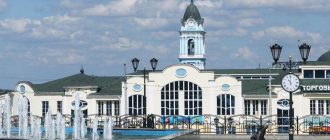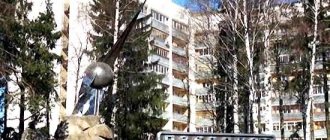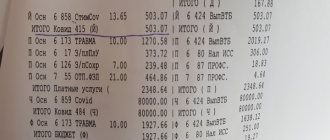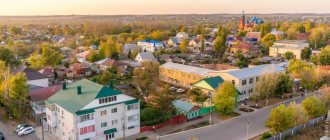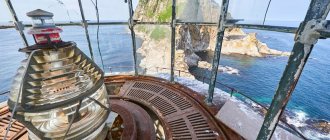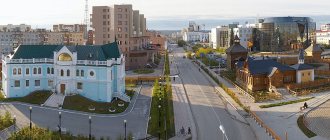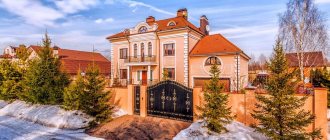| city of regional subordination with administrative territory[1] / urban district[2] | |
| city of Losino-Petrovsky urban district Losino-Petrovsky | |
| Flag | Coat of arms |
This article is about the territorial unit.
About the city, see Losino-Petrovsky. Losino-Petrovsky urban district
- a municipal entity in the east of the Moscow region of Russia.
Within the framework of the administrative-territorial structure, it corresponds to the city of regional subordination Losino-Petrovsky
with the administrative territory[4][5].
The administrative center is the city of Losino-Petrovsky.
History[ | ]
During the implementation of the Federal Law “On the General Principles of the Organization of Local Self-Government in the Russian Federation” (No. 131-FZ of October 6, 2003), municipalities were created in the Moscow region. Included in the municipal formation is the Losino-Petrovsky urban district
1 settlement was included - the city of Losino-Petrovsky, which, within the framework of the administrative-territorial structure, had the status of a city of regional subordination.
By the law of May 23, 2022, the urban settlement of Sverdlovsky and the rural settlement of Aniskinskoye of the Shchelkovsky municipal district were abolished and on June 5, 2022 included in the Losino-Petrovsky urban district[6].
By decree of the governor of the Moscow region dated June 28, 2018, the settlements of the annexed territories were subordinated to the city of Losino-Petrovsky[8]. On February 5, 2022, a bill was introduced into the Moscow Regional Duma, according to which the status of Losino-Petrovsky as an administrative-territorial unit of the region was expanded to a city of regional subordination with an administrative territory[9].
Subsequently, 2 territorial departments were formed within the administration of the city district: Sverdlovsk and Aniskinsky within the boundaries of the former urban and rural settlements, respectively[10].
Attractions
- In the city there are: a monument to Peter I;
- monument to St. Nicholas the Wonderworker;
- memorial to fallen defenders of the Fatherland;
- monument in honor of those killed during the Second World War.
- To the east of the city there is a small Glinka estate, where Field Marshal Y. V. Bruce, one of the associates of Peter I, lived in retirement.
- In Losino-Petrovsky there are three parishes of the Russian Orthodox Church, belonging to the Losino-Petrovsky church deanery district of the Moscow diocese with active churches: [36]Skorbyashchenskaya (1819), Trinity (1822), Nikolskaya (1822).
- Church "Joy of All Who Sorrow"
- Trinity Church
- St. Nicholas Church
Population[ | ]
| Population | ||||||
| 2009[11] | 2010[12] | 2011[11] | 2012[13] | 2013[14] | 2014[15] | 2015[16] |
| 22 393 | ↗22 550 | ↗23 182 | →23 182 | ↗23 694 | ↗24 290 | ↗24 726 |
| 2016[17] | 2017[18] | 2018[19] | 2019[20] | 2020[21] | 2021[3] | |
| ↗25 266 | ↗25 370 | ↗25 424 | ↗47 827 | ↗49 904 | ↗52 325 | |
The population of the urban district of Losino-Petrovsky, the urban settlement of Sverdlovsky and the rural settlement of Aniskinskoye, which made up the newly formed urban district of Losino-Petrovsky on June 5, 2022, at the beginning of 2022 was &&&&&&&&&046787.&&&&&046 787[19] people.
Economy
Main specializations: light industry and services. The city has medium and small private enterprises, a silk weaving factory, supermarkets, a bath complex, a medical center, and a savings bank. In the past there was a poultry farm[34].
Currently, the Losino-Petrovsky urban district is being transformed as a result of complex development. On the territory of the city it is planned to build modern multi-storey residential complexes[35] with their own infrastructure and internal amenities designed for the comfortable living of future residents of the complex. The development area will be more than 13.43 hectares. Future new buildings will house retail and service enterprises: pharmacies, cafes, supermarkets, office space.
Settlements[ | ]
The urban district includes 18 settlements, including 2 urban - 1 city and 1 urban-type settlement (working village) - and 16 rural settlements:
| List of settlements | ||||
| № | Locality | Type | Population | former municipality |
| 1 | Aniskino | village | ↗836[22] | rural settlement Aniskinskoye |
| 2 | Anichkovo[23][24] | village | rural settlement Aniskinskoye | |
| 3 | Biocombine | village | ↗4604[22] | rural settlement Aniskinskoye |
| 4 | Carmolino | village | ↗38[22] | rural settlement Aniskinskoye |
| 5 | Housings | village | ↗1130[22] | urban settlement Sverdlovsk |
| 6 | Leonikha | village | ↗246[22] | rural settlement Aniskinskoye |
| 7 | Losino-Petrovsky | city | ↗25 404[21] | urban district Losino-Petrovsky |
| 8 | Mednoe-Vlasovo | village | ↘436[22] | rural settlement Aniskinskoye |
| 9 | Mizinovo | village | ↗1220[22] | rural settlement Aniskinskoye |
| 10 | Mityanino | village | ↗53[22] | urban settlement Sverdlovsk |
| 11 | Orlovka | village | ↗66[22] | urban settlement Sverdlovsk |
| 12 | Oseevo | village | ↗341[22] | urban settlement Sverdlovsk |
| 13 | Raiki | village | ↘84[22] | rural settlement Aniskinskoye |
| 14 | Savinki | village | ↗66[22] | urban settlement Sverdlovsk |
| 15 | Sverdlovsky | workers' village | ↗13 182[21] | urban settlement Sverdlovsk |
| 16 | Toporkovo | village | ↘63[22] | rural settlement Aniskinskoye |
| 17 | Ulitkino | village | ↘213[22] | rural settlement Aniskinskoye |
| 18 | Youth | village | ↗1351[22] | rural settlement Aniskinskoye |
Transport
There are buses and minibuses operating in the city. 362 art. Monino-Losino-Petrovsky (Deli) - Moscow (metro Shchelkovskaya) bus 506 Losino-Petrovsky (Deli) - Moscow (metro Shchelkovskaya) minibus 886 Losino-Petrovsky (Market) - Moscow (metro Perovo) minibus
26 Shchelkovo (Zarechny microdistrict) - st. Monino 30 Losino-Petrovsky (Factory No. 2) - Monino The average travel time by bus or minibus to Moscow (metro station Shchelkovskaya) is 40 minutes. The Monino railway station of the Yaroslavl direction of the Moscow Railway is located 3 kilometers from the city. The travel time of electric trains from the Yaroslavsky station is about 1 hour for express trains and 1 hour 15 minutes for the next ones with all stops, from the Fryazevo station - about 25 minutes.
How to get on the excursion
During restoration work, it is possible to go on a tour only by prior arrangement. You can do this by calling 8-916-302-50-08. By calling this number you will find out the operating hours of the museum-estate and get answers to other organizational questions.
You won't be able to just come and get inside. You may find yourself in front of a tightly closed fence...
Behind which only a loud barking dog will tell you the history of the estate, and you can see several buildings through the metal gate gate.
I went to Glinka with an excursion group. Before this, I had been looking for such an opportunity for a long time. All the information on the Internet boiled down to how difficult it is to get inside now, that the estate is closed, and so on...
And then by chance I found a wonderful one who organizes excursion trips here. The guys who organize the tours are professionals in their field. Everything was very well organized, the excursion went well, and I never regretted going. And the reviews from other participants in our trip were very good.
Glinka is far from the only place where tourist groups gather. "Manor Express" organizes walking, bus and car routes to various historical places and estates in Moscow and the Moscow region. For example, during this trip we visited 3 ancient estates, including the estate in Monino. The route took the whole day: from 9 to 21 hours!
If you are interested in this information, type “usadboved.ru” in Google or follow the link to their website: www.usadboved.ru. There you will find out opening hours, travel schedules and, most importantly, sign up for an interesting excursion.
On the territory of the estate, Irina Yuryevna, an amazing person who is passionate about her work, gave us a tour. She worked here during the existence of the first Yakov Bruce Museum, which was created on the territory of his estate in Glinki by Ivan Nikolaevich Filimonov. Since then, Irina Yuryevna became his student and colleague. Her inspired story about the estate, about the owner Bruce, about the events taking place on the estate for several hours made me forget about the rest of the world and immerse myself in the history of this amazing place in Monino.
As a rule, Irina Yuryevna conducts excursions around the Glinka estate every weekend. You can also come here on weekdays (by prior arrangement). In this case, the guide will be different.
Participation in an excursion group for 1 person costs 400 rubles. For students and pensioners, getting to know Bruce and his estate will cost 2 times less.
Church of St. John the Evangelist then and now
The first mention of the Church of St. John the Evangelist dates back to 1710.
Since 1733, the village and the church located there were owned by the Bruce family. In 1753 A.R. Bruce submits a petition for the construction of a new temple to replace the church that has fallen into disrepair on the territory of the village of Mizinovo. Such permission was received. In 1753, construction of a stone church began on the territory belonging to the estate; a temple was built in the name of the Apostle and Evangelist John the Theologian with an additional chapel in the name of the Holy Prince Alexander Nevsky. The consecration of the temple took place in 1756.
The church was very beautiful; its shape resembled a small ship. In 1787, the Bryusov tomb was built nearby. It contained the burials of Alexander Bruce and his third wife Natalia.
But the wife of Yakov Alexandrovich Bruce (the great-nephew of Yakov Vilimovich Bruce) was buried in the altar of the temple itself. Above the burial place of Praskovya Alexandrovna Rumyantseva, the husband installed an amazingly beautiful five-meter tombstone. This was discussed above in this article, where we talked about the later owners of the Glinka estate.
By 1883, the temple had further increased in size. A new refectory with Alexander Nevsky and Bogolyubsky chapels was added. A bell tower was also erected.
During Soviet times, in 1934, the church was rebuilt as a residential building for a sanatorium, and the remains of those buried here were lost. This is how a beautiful church building with columns at the entrance turned into a 4-story rectangular residential box.
The skeleton of the temple has survived to this day, but nothing remains of its original appearance. A new wooden church was built nearby. In 2009, it was consecrated in honor of the Intercession of the Most Holy Theotokos.
But the former sanatorium building, built on the site of the former church, is now just ruins.
They say that it was in disrepair back in the 20th century, and there was an idea to restore it for the 1980 Moscow Olympics. But something didn’t work out then. There was another attempt to restore the structure in 1991. But the reconstruction ended in failure, and the building, now a dormitory, continued to collapse.
Since then, the building has been collapsing, with quite tall trees peeking out of the empty window openings.
There is also a tree growing on the remains of the 3rd floor balcony.
The roof of the building has collapsed, and there is a huge hole in the side wall at the end of the building.
On the opposite side there are still massive columns that apparently stood at the entrance to the building.
And if you imagine that all this stands on the site of an ancient destroyed cemetery, then in general it somehow becomes sad and depressing to be in such an environment.
A little about the owner’s personal life
Lots of Margaritas
Yakov Vilimovich was married, and married happily. All his life he and his wife loved and cared for each other. Yakov Vilimovich's wife's name was Margarita von Manteuffel. She was the daughter of a general, a native of the Baltic states.
They also named their first daughter Margarita, but she lived only a couple of months. In general, the Bryusov family was lucky with Margarita women. There were several of them in the Bruce family. There is such an interesting story about one of them.
The mother of King Robert 1 of Scotland (the ancestor of the Scotsman Bruce) was also called Margaret or Marjorie (which is the same thing), Countess of Carrick. She was married, but her husband died during the Crusade. One day a handsome man came to her to tell the countess about the death of her husband.
Having fallen in love with him at first sight, the woman captivated him. That is, without quotes, she literally captured her and held her until he gave up and agreed to marry her. This is how, in general, the lady was decisive.
The second daughter in the family of Jacob Bruce, Natalya, died when she was only one and a half years old (according to some reports, she lived for 6 months). So there were no children in the Bruce family. His wife died just a year after they settled on Glinka's estate. After her, Jacob Bruce lived alone for another 8 years.
Legends, myths and... knowledge
Bruce did not like social society and very rarely attended balls and other events, considering them a waste of time.
Everything that was interesting to him was in his home: books, documents, instruments for experiments and observations of the night luminaries. It was for this passionate passion for science and his extensive knowledge that Jacob Bruce was known among the common people as a mysterious mystic, magician and sorcerer. His name was simply shrouded in rumors! They were all related to magic, and there were a lot of them!
Local peasants told each other in horror:
- how Bruce was seen flying in and out of his office window on a fire-breathing dragon;
- that, bored in the summer heat, it didn’t cost him anything to freeze the water on the pond and go ice skating;
- they talked about the elixir of youth;
- about a gazebo in the garden of a scientist-wizard, in which music began to play only at the wave of the hand of the owner of the house;
- They also talked about a robot girl who was invented by the magician Jacob Bruce.
By the way, not all the rumors were just nonsense. After the death of the inventor, designs and drawings of the first robot were found in his notes. As the scientist bequeathed, all his notes - and they fit in only 35 (!!!) carts - were transferred to the Academy of Sciences of St. Petersburg.
Bryusov family
Since Bruce had no children, after his death Glinka’s estate near Moscow began to belong to his nephew Alexander. Alexander was married three times. And for the first time on Princess Anastasia Dolgorukova.
His second chosen one was Ekaterina, again, Dolgorukova. At one time she was considered the bride of Emperor Peter 2, but the marriage did not take place due to the sudden illness and death of the groom. Alexander's third wife was Natalya Kolycheva. She came from an ancient family of Moscow boyars.
The next owner of the Glinka estate was Alexander's son Yakov. He was the last of the Russian descendants of the Bryus family.
Yakov Alexandrovich was the governor of Moscow, and his wife, Praskovya, was Catherine 2’s maid of honor. And even more than a maid of honor. You could say they were friends. Catherine affectionately called her friend Brusha, Paranya.
From historical documents of those years it follows that Praskovya was not distinguished by strict morals. And the friendship of the two women was abruptly interrupted when Catherine found her in an unambiguous situation alone with one of her favorites. Praskovya was removed from the court, and she traveled abroad for a long time.
In general, it turned out that husband and wife - Yakov Alexandrovich Bruce and his wife Praskovya - often lived separately from each other. But Yakov Alexandrovich loved his wife. After her death, he commissioned the talented Russian architect Ivan Martos to create an original tombstone with an epitaph for his wife, which began with the words: “To my wife and friend.”
Plans for the near future
Restoration work
In 2016, the entire territory with the adjacent garden was bought by modern philanthropist Vyacheslav Fomichev. Previously, with his own money in 2010, he created a military-technical museum in the village of Ivanovskoye (not far from the town of Chernogolovka near Moscow), and in 2016 he restored the Morozov estate in Noginsk.
Now it is planned to completely restore the Glinka estate and open a full-fledged museum there, filled with exhibits from the life of Bruce and his family estate. In 2022, this is exactly what was happening on the territory of the former beautiful estate of Bruce: it is being built, restored, renovated.
Active reconstruction of old buildings is underway.
They are digging and building something near the former club building.
And if you walk around the club building and look from the opposite side, you can find a beautifully finished piece of the room surrounded by fittings and construction debris. What's there? Cafe or restaurant?
Bruce House Museum
In one of the restored outbuildings of the estate, which is located near the ponds (Bruce’s former “storeroom”), the Yakov Vilimovich Bruce Museum is now open.
The Bruce Public House Museum was located on the estate before; it operated since 1991 and was closed in 2006. Gradually, all the exhibits were removed from the territory of Glinka’s estate to the Shchukovsky Museum of Local Lore.
In 2022, part of the collection was returned.
The newly renovated premises contain antique furniture, portraits of Bruce and his entourage.
We collect old photographs, manuscripts, and objects that belonged to the owners of the Glinka estate for many decades.
Exhibition in the central house of the estate
In the main house there is now also an exhibition dedicated to the era of Peter the Great, whose friend and ally was rightfully the owner of the Glinka estate, Yakov Bruce. A tall sculpture of the Russian emperor greets guests of the estate.
On two floors of the premises there are exhibits dedicated to the history of the estate, objects of decorative and applied art, and a collection of antique furniture.
There are a huge number of watches on the shelves.
There are elegant candlesticks on the floor. And for some reason even a cannon with a cannonball.
Well, since we are talking about military equipment, then we smoothly move on to the next section of the article.
What do tanks have to do with it?
They plan to open a historical exhibition on the territory of the modern Glinka estate in Monino. The first exhibits are already there. There are only two of them so far: a tank and some other military vehicle.
They are located behind the clubhouse in the open forest air. This part of the exhibition is planned to be dedicated to the Soviet period in the life of the Monino estate-sanatorium.
What Field Marshal Bruce's estate looked like
Contrary to the royal ban
The Glinka estate was built in 1727. In the center of the courtyard stood the main house with porticoes, arches and columns. The central part of its façade was occupied by a spacious loggia. The external walls were decorated with decorative patterns made of expensive white stone. All these skillfully crafted elements were harmoniously combined and gave the building an elegant look, both then and now.
Interesting fact: Bruce “Glinka” estate was built of stone! But it is a well-known fact that in those days Peter 1 forbade the construction of stone houses. In fact, Yakov Vilimovich was a law-abiding citizen and very demanding, in this sense, of people and himself. But, apparently, for convenience, he decided to make an indulgence for himself, which he did not often allow himself, to bypass the ban and do as he saw fit.
In addition to the ban on stone construction, such “liberty” at that time cost a lot of money. Maybe that’s why all the buildings built on the estate are low.
Masks on the facade - beautiful and unusual
Another detail on the wall of the house attracts attention, or rather, there are many of them: stone masks on the facade and on the side walls.
Surprisingly, for 300 years nothing has broken in them, not a piece has broken off.
Here too lies the secret of architecture. During construction, white stone was laid into the masonry of the building, and then parts were cut out of it. Masks, aprons, window sills and all decorative elements are all carved entirely from white stone. The base of the building was also made from the same stones.
That is, masks are not a separate part. They were provided for during the preparation of the project. They are not made of plaster stucco, which would not have survived for so many years, but are carved directly into the stone from which the house is built.
White stone masks somehow fall out of the general calm architecture of the building: a relatively small house, nothing flashy or provocative... And suddenly THEY are laughing and grimacing. They say that Bruce’s contemporaries who came to visit him recognized the masks as caricatures of high-ranking nobles of those years.
Moreover, the masks on those sides of the house that overlook Moscow and St. Petersburg show their tongues.
The neighboring building still has pilasters on its sides. It is said that statues were previously located under the stone shells.
Guests come to see Bruce
And also... I have a proposal for you. No, no, you don't need to buy anything. Let's mentally transport ourselves to a hot summer (this is important!) day in 1733 and imagine ourselves as guests of Jacob Bruce.
So, you, Count or Countess X, in a richly decorated carriage, enter the Glinka estate, look at the luxurious house and suddenly notice on its facade a snow-white mask that smiles welcomingly at you.
You also smile back at her, drive closer to the house and greet the famous handsome Scot Yakov Vilimovich (by the way, it is known that Bruce’s height was no less than 1 meter 93 centimeters).
After a tasty treat served by a mechanical girl (they say that the first such robot was invented by Jacob Bruce), viewing the owner’s large collection of curious things, walking among snow-white statues along the paths of a beautiful garden and skating on the frozen water of a pond (do not forget that in the yard summer heat) you are going home.
You say goodbye to the hospitable host, get into the carriage and leave. Having driven away a little, you turn around to wave to the owner, and suddenly you notice that the mask that smiled at you when you arrived is now sadly looking after you and as if saying: “Are you leaving already? So fast? What a pity".
Indeed, on the wall of Bryusov’s house, one of the masks, depending on the angle of view and the distance between you, changes its facial expression. Don't believe me? Go to Glinki and see everything for yourself! But in general, why be surprised?! Bruce was a magician, a wizard, and, part-time, a talented scientist. Or vice versa…
There are a total of 57 masks on the house, and none of them is the same as the other. They say that one of them is a caricature of the owner of the house himself.
But what do the rest mean? What did Bruce want to say by decorating the walls of his house with them? Another mystery of the mysterious Bruce the wizard.
Now we can only guess about all this. But we learned about one more trait in Bruce’s character. This means that he was not always so serious and sat with a smart look behind his books. And this is exactly how he looks in most portraits that have survived to this day.
This means that boyish enthusiasm sometimes awoke in this learned man.
Scientific center of the 18th century in Glinki
The interior of the house is also a little unusual. Two large halls were located above each other and connected by a staircase. There were verandas on both sides of the building. And on the large open loggias of the house, Bruce built an observatory, equipping it with the latest technology of the time and the latest instruments for observing the stars. That is, initially the house was one-story with open verandas on the roof.
Later, these spacious verandas were fenced off on the sides with walls, resulting in a rectangular two-story house. The first floor of the building looked the same as it does now. But there were no right and left rooms on the second floor. Try to “take down” the two outer windows, then “remove” the roof. Now imagine a spacious hall with columns in the center, and on the sides there are open areas for observing the celestial constellations.
This was Bruce's third observatory. The first classroom was located in the Sukharev Tower in Moscow, which was dismantled in 1934, the second was a wooden one in St. Petersburg (it also did not survive). But the third observatory in the Glinka estate has “survived” to this day.
On the opposite side there is another entrance to the building, with columns of a slightly different shape. And above it is an open balcony.
In general, the house, which is now central to the estate, resembled a scientific center for research, and Yakov Vilimovich did not spare money on its arrangement. And the owner of the estate lived in another house, nearby. According to some information that has reached us, the house was made of wood, and has not survived to this day.
Modesty and luxury of the estate
The architectural ensemble of the Glinka estate complex is one of the few in Russia that has been completely preserved from the Peter the Great era. Here is a plan of the estate on a sketch map.
And here it is from above, filmed by a modern drone. On it are those buildings that have been preserved from Bryusov’s estate, as well as relatively new buildings.
In addition to the central house-laboratory, on Bruce’s estate there was a guardhouse building where guard soldiers lived. After all, a person of such high rank as Bruce was entitled to lifelong protection. Previously it was a one-story building. The second floor was added later, in the 19th century.
Here is another, already 3-story service wing with a strange arrangement of windows.
In addition, on the territory of the vast estate there was a stable yard
and a long corner building that previously housed greenhouses, which also survive to this day.
There were also buildings to store Bruce's large collection of unusual and wonderful things, as well as his library, containing mainly scientific books in 14 different languages. All wings had a through passage.
On the Internet, a photograph was found from 1897, which depicts one of the buildings of Bruce’s estate.
Manor ponds for magic
Right next to the house there was a garden with ponds. The garden paths were decorated with numerous snow-white sculptures. Now there are 3 ponds on the estate: two lower and one upper (at a higher level).
The modern lower ponds have merged into a single body of water. But previously there was a division between them, and it was through them that 3 centuries ago the elegant entrance bridge leading to the estate of Jacob Bruce passed.
The upper pond is located behind the central house. There is no information available as to whether it was dug during the time of Bruce or whether it was made at a later period.
Some scientists and researchers claim that it was on this pond that the owner of the estate performed his trick, which delighted his contemporaries, and the description of which has survived even to this day. The point is (as was already mentioned just above in this article) that Bruce’s guests rode boats on the water surface on a hot summer day, relaxing and admiring the park.
Next, the owner invited everyone into the house to taste the treats. In the evening after the feast, when it got dark, the guests went out into the street again and couldn’t believe their eyes. Instead of a surface of water, there was a real skating rink in front of them! Yakov Bruce gave skates to all the guests who wanted it and who couldn't believe their eyes, and it was as if they were joyfully skating on real ice on a winter evening.
Modern scientists have provided an “evidence base” for this miracle. And they justified with their calculations that this could have been done using the knowledge and techniques of the 18th century.
For those who want to understand how this was done, and maybe want to repeat Bruce’s experience, click on the picture to enlarge it and study the technology.
It is interesting that the researcher A. Grech, who devoted many years of his life to the study of Moscow and ancient estates near Moscow, saw complex Masonic signs in the interweaving of park paths here. Can you see them? Personally, I had no time for secret signs: it was so pleasant and comfortable to walk along the ancient park paths and alleys surrounded by ancient linden trees.
The entire territory of Yakov Bruce's estate in Monino was cut up by underground passages. Not only did they connect all the buildings, some of them came to the surface only a few kilometers from the house. According to legend, it is there, in the underground tunnels, that part of Bruce’s scientific works and his countless treasures are hidden. Dowsing specialists recorded anomalies in various parts of the estate, which confirms the hypothesis of the presence of underground passages.
